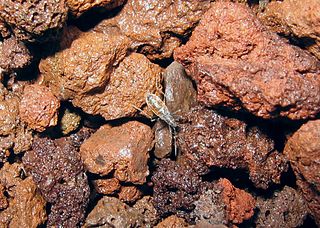
Pyrrhocoridae is a family of insects with more than 300 species world-wide. Many are red coloured and are known as red bugs and some species are called cotton stainers because their feeding activities leave an indelible yellow-brownish stain on cotton crops. A common species in parts of Europe is the firebug, and its genus name Pyrrhocoris and the family name are derived from the Greek roots for fire "pyrrho-" and bug "coris". Members of this family are often confused with, but can be quickly separated from, Lygaeidae by the lack of ocelli on the top of the head.

The Lygaeidae are a family in the Hemiptera, with more than 110 genera in four subfamilies. The family is commonly referred to as seed bugs, and less commonly, milkweed bugs, or ground bugs. However, while many of the species feed on seeds, some feed on sap (mucivory) or seed pods, others are omnivores and a few, such as the wekiu bug, are carnivores that feed exclusively on insects. Insects in this family are distributed across the world. The family was vastly larger, but numerous former subfamilies have been removed and given independent family status, including the Artheneidae, Blissidae, Cryptorhamphidae, Cymidae, Geocoridae, Heterogastridae, Ninidae, Oxycarenidae and Rhyparochromidae, which together constituted well over half of the former family.

Nysius wekiuicola is a species of wēkiu bug endemic to the area surrounding the summit of Mauna Kea, on the island of Hawaiʻi. It is closely related to Nysius aa, which is endemic to the summit of the neighboring Mauna Loa.

Nysius aa is a species of wēkiu bug endemic to the area around the summit of Mauna Loa, on the island of Hawaiʻi. It is closely related to Nysius wekiuicola, which is another species of wēkiu bug endemic to the nearby Mauna Kea.

Nysius is a genus of false chinch bugs in the family Lygaeidae. At least 100 described species are placed in Nysius.

Arocatus roeselii is a species of lygaeid bug.

Coleophora deauratella is a moth of the family Coleophoridae. It is found in most of Europe, Asia Minor, Tasmania, North America and New Zealand.

Nysius huttoni, the wheat bug, is a species of seed bug, an insect in the family Lygaeidae. It was formerly endemic to New Zealand, but was introduced to Europe, including Belgium, France, the Netherlands, and the United Kingdom. In New Zealand, it is an economically important pest of wheat and crops in the mustard family.

Cosmopterix aurotegulae is a moth of the family Cosmopterigidae. It is known from Veracruz, Mexico.

Lygaeus equestris, common name Black-and-Red-bug, is a species of ground bugs belonging to the family Lygaeidae, subfamily Lygaeinae.

Oxycarenus hyalinipennis, common name cotton seed bug, is a species of plant bug belonging to the family Lygaeidae, subfamily Oxycareninae.

Eucosma cana, the hoary bell, is a species of moth of the family Tortricidae.
Oedancala dorsalis is an insect, found in the superfamily Lygaeoidea which is one of the largest varied family of Heteroptera of Hemiptera. Seed bugs are a very diverse family of seed feeders found on various types of vegetation. There are four Nearctic species in this genus. O. bimaculate and O. cubana are neotropical species that barely make it into the United States.

Arocatus melanocephalus, the elm seed bug, is a true bug in the family Lygaeidae. The species was initially described by Johan Christian Fabricius in 1798, and Maximilian Spinola designated it to be the type species of the genus Arocatus in 1837. This bug is native to Europe but has been introduced to North America.

Plagiognathus arbustorum is a species of insects in the family Miridae, the plant bugs.

Kleidocerys resedae, the birch catkin bug, is a species of seed bug in the family Lygaeidae. It is found in Europe and Northern Asia and North America.
Nysius fuscovittatus is a species of seed bug in the family Lygaeidae. It is found in North America.

Lygaeus kalmii, known as the small milkweed bug or common milkweed bug, is a species of seed bug in the family Lygaeidae. It is found in Central and North America.

Megalonotus praetextatus is a species of seed bug in the family Rhyparochromidae.

Crompus opacus is a species of seed bug in the family Lygaeidae. It is a terrestrial insect found only in Australia. Crompus opacus is not currently listed under the Territory Parks and Wildlife Conservation Act 1976 in the Northern Territory of Australia.

















